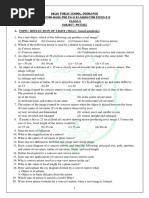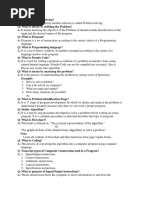Click For Answer
Click For Answer
Uploaded by
Noman QadeerCopyright:
Available Formats
Click For Answer
Click For Answer
Uploaded by
Noman QadeerOriginal Title
Copyright
Available Formats
Share this document
Did you find this document useful?
Is this content inappropriate?
Copyright:
Available Formats
Click For Answer
Click For Answer
Uploaded by
Noman QadeerCopyright:
Available Formats
A 5 cm tall object is placed perpendicular to the principal axis of a convex lens of focal- length 20 cm.
The
distance of the object from the lens is 30 cm. Find the:
(i) position
(ii) nature
(iii) size of the image formed.
4.5 cm needle is placed 12 cm away from a convex mirror of focal length 15 cm. Give the location of
image and magnification. Describe what happens to the image as the needle is moved farther from the
mirror.
Rohit placed a pencil perpendicular to principal axis in front of a converging mirror of focal length 30 cm.
The image formed is twice the size of the pencil. Calculate the distance of the object from the mirror.
An object is placed at a distance of 25 cm away from a converging mirror of focal length 20 cm. Discus
the effect on the nature and position of the image if the position of the object changes from 25 cm to 15
cm. Justify your answer without using mirror formula.
click for answer
A 5cm tall object is placed perpendicular to the principal axis of a convex lens of focal length 10 cm. The
distance of the object from the lens is 15 cm. Find the nature, position and size of the image. Also find its
magnification
The refractive index of Ruby is 1.71. What is meant by this statement?
(b) The refractive index of some medium are given below:
Crown glass- 1.52
Water- 1.33
Sapphire- 1.77
In which of the medium is the speed of light
(i)maximum
(ii)minimum
(iii) Calculate speed of light in sapphire.
. A 10 cm tall object is placed perpendicular to the principal axis of a convex lens of focal length 30 cm.
The distance of the object from the lens is 20 cm. Find the:
(a)Position
(b)Nature
(c)Size of the image formed.
A 6 cm object is placed perpendicular to the principal axis of a convex lens of focal length 15 cm. The
distance of the object from the lens is 10 cm. Find the position, size and nature of the image formed,
using the lens formula.
An object is placed at infinity from a concave mirror of focal length 10 cm. Find the position and nature of
image formed. Draw a ray diagram to show the formation of image.
(a) Define focal length of a spherical lens.
(b) A divergent lens has a focal length of 30 cm. At what distance should an object of height 5 cm from
the optical centre of the lens be placed so that its image is formed 15 cm away from the lens? Find the
size of the image also.
(c) Draw a ray diagram to show the formation of image in the above situation.
Answers
You might also like
- Mirror NumericalsDocument2 pagesMirror NumericalsMATHILI80% (10)
- Class - 10 - Light - NumericalsDocument6 pagesClass - 10 - Light - Numericalsray80% (15)
- Numerical Problems: Concave MirrorDocument5 pagesNumerical Problems: Concave MirrorRaj Kumar63% (8)
- 21Document1 page21Noman QadeerNo ratings yet
- Lens and Mirror NumericalsDocument1 pageLens and Mirror Numericalssiyakshetri11No ratings yet
- Mirror FormulaDocument18 pagesMirror FormulaManoj KumarNo ratings yet
- Numerical Problem Class 10 Chapter LightDocument5 pagesNumerical Problem Class 10 Chapter Lightmitvapatel1178No ratings yet
- Numerical Problems on Light_Class XDocument6 pagesNumerical Problems on Light_Class Xhetpatel25062009No ratings yet
- LIGHT (Reflection and Refraction Numericals)Document2 pagesLIGHT (Reflection and Refraction Numericals)naitikroopeshmehtaa.6No ratings yet
- 05 - 53 - 17 - 16 - 09 - 2024 - Light QiestionsDocument1 page05 - 53 - 17 - 16 - 09 - 2024 - Light Qiestionsoutcast7212No ratings yet
- Mirror Formula - NumericalsDocument4 pagesMirror Formula - NumericalsSen Gaming Yt100% (4)
- LIGHT - MIRROR Practice QuestionsDocument2 pagesLIGHT - MIRROR Practice Questionsshrish000000100% (1)
- Spherical Mirrors Numericals 2Document1 pageSpherical Mirrors Numericals 2Aadhil SalimNo ratings yet
- CL 10 NUMERICAL OPTICS M.SDocument14 pagesCL 10 NUMERICAL OPTICS M.Smanya06joshiNo ratings yet
- QB 10Document12 pagesQB 10Tapas BanerjeeNo ratings yet
- Reflection of Light NUMERICALS Class 10Document3 pagesReflection of Light NUMERICALS Class 10V JananiNo ratings yet
- Homework 5 July 2024Document2 pagesHomework 5 July 2024ywhoare69No ratings yet
- Numericals LightDocument2 pagesNumericals Lightmukeshsgf5No ratings yet
- Numericals Based On Convex LensDocument2 pagesNumericals Based On Convex LensYash Saxena90% (10)
- 9. Light (Numerical Based) X Class R.KDocument2 pages9. Light (Numerical Based) X Class R.KYUVI GAMERNo ratings yet
- Light - Reflection and Rarefaction (Assignment)Document2 pagesLight - Reflection and Rarefaction (Assignment)amit mongiaNo ratings yet
- light_2024_Rev_3Document7 pageslight_2024_Rev_3tharunkarthicksrinivasanNo ratings yet
- Physics: Practice Worksheet (HHW)Document4 pagesPhysics: Practice Worksheet (HHW)Anil BhattNo ratings yet
- Assignment Class 10 LightDocument4 pagesAssignment Class 10 LightAnkitesh ShankarNo ratings yet
- LIGHTDocument4 pagesLIGHTkrishavsurya259No ratings yet
- LensDocument2 pagesLensAzaz ShabhaiNo ratings yet
- Homework 4 July 2024Document2 pagesHomework 4 July 2024ywhoare69No ratings yet
- Practice Worksheet Light (Reflection-Mirror)Document3 pagesPractice Worksheet Light (Reflection-Mirror)[ [ ] ] SARTHAK SHINDENo ratings yet
- LIGHT Worksheet - ReflectionDocument4 pagesLIGHT Worksheet - Reflectionmdashique217No ratings yet
- PRACTICE QUESTIONS On LensDocument5 pagesPRACTICE QUESTIONS On LensgeetasatyapriyaNo ratings yet
- LightDocument2 pagesLightJeeva JohnNo ratings yet
- Important Question1Document1 pageImportant Question1ankitza1007No ratings yet
- WS 1 24 25Document2 pagesWS 1 24 25rs.aishwarya2709No ratings yet
- Ref. of Light - 1Document1 pageRef. of Light - 1KusumNo ratings yet
- Lens Formula Worksheet 3.oaoDocument1 pageLens Formula Worksheet 3.oaodevanshpokhriyal500No ratings yet
- Chapter 9 Problemset 1Document2 pagesChapter 9 Problemset 1lsanthijeyNo ratings yet
- Light Mirror QuestionsDocument6 pagesLight Mirror Questionskrishavsurya259No ratings yet
- Refraction NumericalsDocument1 pageRefraction NumericalsShreya AjithNo ratings yet
- Light Part 1 - 063835Document3 pagesLight Part 1 - 063835Nestory mahunjaNo ratings yet
- X RK Phy Slabs, Convex, Concave Lens AssignmentDocument3 pagesX RK Phy Slabs, Convex, Concave Lens AssignmentYUVI GAMERNo ratings yet
- Light Part 2 - 091746Document2 pagesLight Part 2 - 091746Nestory mahunjaNo ratings yet
- Light Numericals-1Document3 pagesLight Numericals-1MerlinNo ratings yet
- Worksheet 1Document1 pageWorksheet 1Anagha Krishna KumarNo ratings yet
- Lens Equation WorksheetDocument1 pageLens Equation WorksheetOnigiri Kawaii100% (1)
- Mirror Numericals (1) - WatermarkDocument2 pagesMirror Numericals (1) - WatermarkconvictionclassesNo ratings yet
- Physics Light ProblemsDocument16 pagesPhysics Light ProblemsKARIKALAN D100% (2)
- Mirror NumericalsDocument2 pagesMirror NumericalsSandyNo ratings yet
- LIGHT REFLECTION NUMERICALSDocument3 pagesLIGHT REFLECTION NUMERICALSlakshgarg1975No ratings yet
- Worksheet - 4 (CH 10 - Light Reflection and Refraction - 10TH Cbse)Document2 pagesWorksheet - 4 (CH 10 - Light Reflection and Refraction - 10TH Cbse)pushpendra pratap singhNo ratings yet
- Question 1.-WPS OfficeDocument1 pageQuestion 1.-WPS OfficeEnjoy StudyingNo ratings yet
- Worksheet - LightDocument3 pagesWorksheet - LightGowri VenkatNo ratings yet
- Ray Optics Sambhav DPP #1 Class 12Document4 pagesRay Optics Sambhav DPP #1 Class 12Earn KnowledgeNo ratings yet
- Assignment Reflection NumericalsDocument2 pagesAssignment Reflection NumericalsRavinder Pal SinghNo ratings yet
- DocumentDocument1 pageDocumentsoorajtripperzNo ratings yet
- SCAssign 1Document1 pageSCAssign 1lokimanNo ratings yet
- WORKSHEET AND NUMERICALS Light - CopyDocument30 pagesWORKSHEET AND NUMERICALS Light - Copysahamanika043No ratings yet
- Light QuestionsDocument9 pagesLight QuestionsTxv RushNo ratings yet
- Numericals Bases On Spherical MirrorsDocument4 pagesNumericals Bases On Spherical MirrorscktmnabiramiNo ratings yet
- Light - Reflection and Refraction Part 1Document6 pagesLight - Reflection and Refraction Part 1Saji JayarajNo ratings yet
- Light Practice Sum CB10Document2 pagesLight Practice Sum CB10kashyapkalita666No ratings yet
- Viewing the Constellations with Binoculars: 250+ Wonderful Sky Objects to See and ExploreFrom EverandViewing the Constellations with Binoculars: 250+ Wonderful Sky Objects to See and ExploreNo ratings yet
- MeasureDocument1 pageMeasureNoman QadeerNo ratings yet
- Assignment Class 4Document1 pageAssignment Class 4Noman QadeerNo ratings yet
- Mock1 Computer 2021Document26 pagesMock1 Computer 2021Noman QadeerNo ratings yet
- Air, Water & Weather Class 4 (Autosaved)Document7 pagesAir, Water & Weather Class 4 (Autosaved)Noman QadeerNo ratings yet
- 11Document1 page11Noman QadeerNo ratings yet
- BDocument1 pageBNoman QadeerNo ratings yet
- HTML Basics PracticalsDocument18 pagesHTML Basics PracticalsNoman QadeerNo ratings yet
- S.No. Name Fathers Name Class VI: Section Girls Teacher RabiaDocument56 pagesS.No. Name Fathers Name Class VI: Section Girls Teacher RabiaNoman QadeerNo ratings yet
- ComputerDocument12 pagesComputerNoman QadeerNo ratings yet
- Requisition List For Teaching Online Department: SCIENCE (Primary & Sec. SECTION)Document3 pagesRequisition List For Teaching Online Department: SCIENCE (Primary & Sec. SECTION)Noman QadeerNo ratings yet
- 2 2jun074Document12 pages2 2jun074Noman QadeerNo ratings yet
- AbczzDocument2 pagesAbczzNoman QadeerNo ratings yet
- Review: QuestionsDocument6 pagesReview: QuestionsNoman QadeerNo ratings yet
- 9th Class MCQs Key of Computer Science Paper (2011)Document1 page9th Class MCQs Key of Computer Science Paper (2011)Noman QadeerNo ratings yet
- Chapter 3 SLOsDocument35 pagesChapter 3 SLOsNoman Qadeer100% (1)
- Computer Science SSC 1 Paper IDocument8 pagesComputer Science SSC 1 Paper INoman QadeerNo ratings yet
- Engro Model School: Mr. Muhammad Azhar MalikDocument8 pagesEngro Model School: Mr. Muhammad Azhar MalikNoman QadeerNo ratings yet
- H1301-0911110 UnlockedDocument4 pagesH1301-0911110 UnlockedNoman QadeerNo ratings yet
- M.asif ShabbirDocument1 pageM.asif ShabbirNoman QadeerNo ratings yet
- Questions: Transport From Bayswater: Complete The Table BelowDocument2 pagesQuestions: Transport From Bayswater: Complete The Table BelowNoman QadeerNo ratings yet
















































































